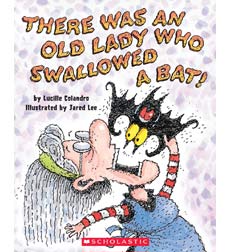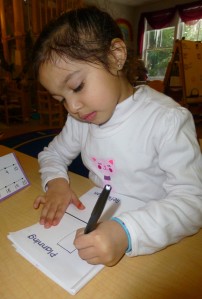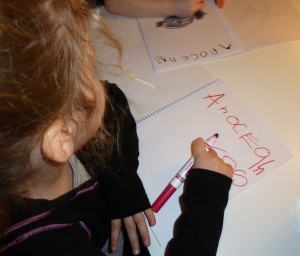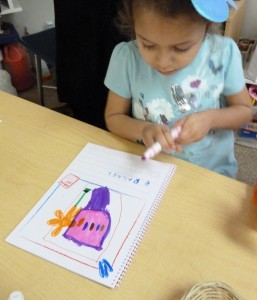 In the spirit of Halloween, we read the story There Was an Old Lady Who Swallowed a Bat by Lucille Colandro and then did a journal entry about some other Halloween items the little old lady might eat. These were their answers…
In the spirit of Halloween, we read the story There Was an Old Lady Who Swallowed a Bat by Lucille Colandro and then did a journal entry about some other Halloween items the little old lady might eat. These were their answers…
Too Many Pumpkins
Recently, our class started reading a new story entitled, Too Many Pumpkins by Linda White. The story begins with a young woman who does not like pumpkins, based on a childhood memory where she had to eat pumpkins for every meal for two weeks straight. As the woman gets older, she vows never to look at a pumpkin again! Until, she unwillingly finds herself with a whole crop of giant pumpkins in her front yard!
At this point in the story, we decided to pause our reading to ask, “How do you think she will get rid of all the pumpkins?” The students had so many wonderful ideas, we made a journal entry about it! These were their ideas.
Planning and Reflection Journals
 You might have noticed that I mentioned Planning and Reflection Journals last week. We introduced these slowly, beginning the 3rd week of January. In fact, my giant version was probably spotted hanging from the front door on the mornings of the first few days. For three days, I wrote my plans for the morning in my journal and shared it with the class. I wanted to make sure that the children were familiar with our expectations before they began their own process. I also shared my reflections at the end of each day during this “intro” period.
You might have noticed that I mentioned Planning and Reflection Journals last week. We introduced these slowly, beginning the 3rd week of January. In fact, my giant version was probably spotted hanging from the front door on the mornings of the first few days. For three days, I wrote my plans for the morning in my journal and shared it with the class. I wanted to make sure that the children were familiar with our expectations before they began their own process. I also shared my reflections at the end of each day during this “intro” period.
Last week, the children began being responsible for their own Planning and Reflection Journals. We have woven the activity into the regular routine of the day. After the children complete the Morning Message and choose a center to play in, they saunter over to the table to record their plans for the morning. Either Mrs. Pless or I are sitting with them to provide support as needed. We expect each child to take their time, draw a picture depicting their plans, and use kid-writing to explain their picture.
The first few entries were predictably lacking detail. For instance, many wanted to write, “play with blocks”. We encouraged each child to focus a bit more on the actual goal they hoped to achieve or story they envisioned telling with their play. With more experience, we are beginning to see much more thoughtful planning and play emerging.
We are also using the same journals to reflect on something that we accomplished today. In the past, this was an activity we did orally. You might have heard the chant, “What did you do today? What did you do in Pre-K?” Some of the children use this opportunity to expand on the same topic they wrote about in the morning. Other children write about unrelated activities. Either way, we are asking the children to focus on their memories of the day and present us with one coherent image. Although we sometimes hear fantastical stories (“Today, my dad was the Hulk and he beat up all of the bad guys.”), this is good practice for reflection. With practice, we hope to see more detailed, intricate plans and accurate memory recall.

For the Birds
Before we left for Spring Break, the children drew our attention to an exciting development outside our window. A pair of mourning doves had begun to build a nest in a nearby pine tree. Although we couldn’t see the actual nest, we could see all of the interesting bits the birds were bringing to construct it. This discovery prompted the children to notice the birds milling around on the rest of the playground. Within two minutes, they had spotted a cardinal and a robin, as well.
 With the growing interest, I pulled together my favorite stuffed birds and a bunch of identification guides. You have probably heard the children imitating the sound of the mourning dove. Sadly, this is the only one I am capable of imitating. However, our plush birds do a great job of twittering and tweeting their sweet songs for the children’s listening pleasure.
With the growing interest, I pulled together my favorite stuffed birds and a bunch of identification guides. You have probably heard the children imitating the sound of the mourning dove. Sadly, this is the only one I am capable of imitating. However, our plush birds do a great job of twittering and tweeting their sweet songs for the children’s listening pleasure.
Yesterday, we identified our favorites from our backyard bird collection. After we read a bit about each, the children turned to their journals to record one thing they had learned about their most beloved bird.
[slideshow]
What is in the ocean?

The children have been very curious lately about all things involving the ocean. Many books about sea life have been both brought from home and checked out from our library. Following this new direction, Mrs. Pless and I are excited about moving more deeply into this new topic. We had heard many conversations around the subject, but we wanted to get a better idea of the previous knowledge shared by the class. We asked each to write in their journals and finish the prompt, “An ocean has…” The children displayed a wealth of background on oceans with only a few fun misconceptions. (Alligators don’t usually live in the ocean, right?) The children wrote about sharks and octopuses, fish and crabs. Even a few mermaids made an appearance. It is going to be a thrilling exploration.
Sprouts and Haircuts
 Since planting our grass and basil seeds last week, we’ve seen much change in our room. The grass friends have grown enormously long hair. Today we took a poll to see who might want to give their grass a trim and who would like to let it grow. Surprisingly, most of the children wanted to let it grow. I did have one child tell me very somberly, “We are not allowed to cut our friends’ hair!” She felt a bit better when I explained that I meant the grass, not real hair. I’m wondering if we’ll have more “cutters” once they see the three who voted to trim going at their grass with scissors. One person did have a bit of an epiphany during morning meeting when he realized that it would grow back after the trim.
Since planting our grass and basil seeds last week, we’ve seen much change in our room. The grass friends have grown enormously long hair. Today we took a poll to see who might want to give their grass a trim and who would like to let it grow. Surprisingly, most of the children wanted to let it grow. I did have one child tell me very somberly, “We are not allowed to cut our friends’ hair!” She felt a bit better when I explained that I meant the grass, not real hair. I’m wondering if we’ll have more “cutters” once they see the three who voted to trim going at their grass with scissors. One person did have a bit of an epiphany during morning meeting when he realized that it would grow back after the trim.
While we’ve been watching the grass shoot up this week, we’ve been logging our observations in our journals. The children are using a combination of “kid writing” and known words to write about the pictures that they draw. They have noticed roots growing, soft grass, wet dirt, and two colors on the grass. In this picture, R. is writing about how she sprays the grass with water to help it grow.

Our other plants have not be growing so profusely, but they are steadily changing from a simple pile of dirt. We created bottle planters for our basil plants so that they would stay watered with minimal help. Since their growth is so slow, these new plants have not quite caused the stir that the grass did, but some of the children are excited about the possibility of eating these new leaves. Hopefully, we’ll have at least one large plant per bottle eventually so you can share these at home.


We also began a project at the beginning of the week that I hope turns out as I’ve planned. We began a large classroom garden in a tub with grass seed and a path. The path was constructed using flat rocks the children collected outside. They have suggested that it would be a perfect walkway for ants. Let’s hope we don’t have any of those in our room roaming around! We’ll just have to wait and see how the grass seed does in this container. It is generally kept away from the window, so keep your fingers crossed!

Dinosaur Research
 Finishing up our last week of dinosaur study, many children are still collecting data about their personal research choices. They are choosing facts that they find interesting to write about in their journals. Some of the children have taken to this activity with gusto, writing new facts a few times a week. Others become interested when they see their friends writing about their dinosaurs.
Finishing up our last week of dinosaur study, many children are still collecting data about their personal research choices. They are choosing facts that they find interesting to write about in their journals. Some of the children have taken to this activity with gusto, writing new facts a few times a week. Others become interested when they see their friends writing about their dinosaurs.
This project has a few exciting by-products. The children are finding out that books contain much more than simply stories. Sometimes it comes as a surprise that anything you want to know about can be found in a book. (Many children are sure that most of the information that is available comes from the computer!) We are also provided with the opportunity to explore indexes, table of contents, and glossaries in an authentic way. Later, when we collect information from each child’s study and create a compilation of information, the children will experience the joy of being the “expert” in their own research.

